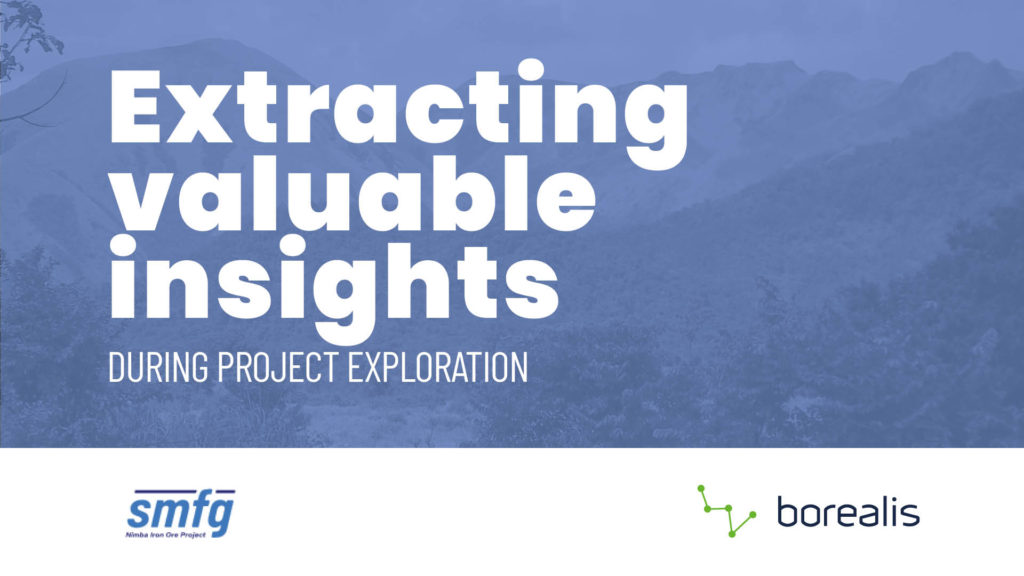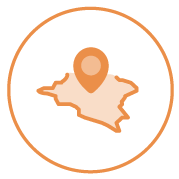Extracting valuable insights
during project exploration
Project description
SMFG’s Nimba Iron Ore Project seeks to responsibly develop a remote deposit in the Nimba mountain range. The project is located in south-eastern Guinea, in an area that was named a natural World Heritage Site in 1981 due to exceptional, globally significant biodiversity. SMFG’s goal is to create a long-term, sustainable mining project that is integrated into the environmental, economic and social fabric of the region.
SMFG is committed to the long-term protection of the mountains as well as their unique species and ecosystems. This will require a transformation of the local economy to support conservation efforts and preserve the integrity of the region. SMFG is working with the local community, environmental partners and the Government of Guinea to ensure that the project is successful, and that it sets an internationally recognized high standard.
Remote Location
Accessible by plane (every 2 to 3 weeks)
Topography
Extreme slopes (over 1,200m)
Biological Diversity
Extraordinary diversity of species and ecosystems
Climate
Dramatic weather fluctuations: intense rain and fog, heat and drought, windstorms
Social Issues
Local Ebola outbreaks, extreme poverty in the region, political instability, corruption
Evaluating Existing Processes
Pepe Kolie started working for SMFG in 2012 as a translator and administrator. He was promoted to Superintendent of the Community and External Relations Department in 2017. When Pepe came into this new role, he took the opportunity to review his team’s tools and methods to see how to improve processes and manage data more efficiently. His director recommended a system that he had used previously for similar projects: Borealis software. Pepe agreed that it sounded perfect for their needs.
Data Management Challenges:
- All project information (including stakeholder contact information, grievances, meeting notes, compliance reports, impact studies, etc.) was stored in project-specific folders on a shared server. Data was not structured or embedded, which made it difficult to locate information in a timely manner.
- Team members sometimes forgot to copy information from their devices to the shared location.
- It was not always clear where to save certain documents, so information was sometimes misplaced or misfiled.
- Without a good data management system, it was easy to lose track of files, documents and other information.
Despite the team’s best efforts, it was hard to stay organized and reporting was arduous work. They realized there had to be a better way.
Objectives
- Implement an information management system to structure and centralize data.
- Facilitate reporting.
- Create institutional memory that is accessible throughout all stages of the project.
When we discovered Borealis, it was like we had been sleeping and we suddenly woke up.
Pepe Kolie, Community and External Relations Superintendent at SMFG
Solution
Borealis stakeholder engagement software with add-on modules: Grievance Management, Social Investment, Compliance Management, and Monitoring & Evaluation.
SMFG uses Borealis for :
Extracting Important Insights During the Project Exploration Phase
While most mining projects don’t implement a dedicated information management system like Borealis until they reach the feasibility phase, SMFG’s commitment to transparent, responsible development has led them to use Borealis at a different stage – during project exploration.
Supporting Corporate Accountability
Creating Institutional Memory
Well-documented institutional memory is an important strategic investment. This corporate history is incredibly valuable to SMFG. Borealis helps users see the entire thread of communications with each of their stakeholders, including how the communications were conducted (letter, face to face, phone, etc.). All relevant information about their interactions with a specific stakeholder can be called up in an instant, which helps them to engage more effectively.

Becoming data management experts
Introducing the system now gives the team time to master their data management system before they have a lot of data to deal with. With Borealis, it’s much simpler to bring new employees up to speed. When someone is out of the office, their data is still accessible to the rest of the team. They also find that they are able to engage more consistently because everyone has access to a complete history of stakeholder interactions.
As the team learned to use the new system, they also took steps to refine their methods. Users still forgot to enter their communications in the system sometimes, which created gaps in their stakeholder data. To address this, Pepe created a notification that reminds users to save their communications in Borealis each afternoon.
This simple step ensures that important information is never forgotten on someone’s personal device.
Widgets and dashboards let the team monitor trends and track their progress at a glance – in fact, their reporting has essentially been automated. They can see how things change over time, like how many communications and grievances were received this week compared to last week. Users can instantly see the number of complaints received at any time and where they are coming from. A weekly report is automatically generated each Friday.
Borealis has greatly improved the way we work, manage information, and interact with stakeholders. It even helps us to assess how we manage our relationships with local communities.
Pepe Kolie, Community and External Relations Superintendent at SMFG
Seeing the Big Picture
Borealis gives the team a more accurate picture of their stakeholders. If someone multiple roles, the team can link those roles to one individual in Borealis, making it easy to see at a glance all the different roles one person has. This allows the team to evaluate each stakeholder’s position more precisely and tailor their approach accordingly. Borealis lets them see how everything is related, which helps them engage more effectively.
“A stakeholder can wear 2 or 3 hats and also be linked to one or more (other) stakeholders, but this information is not always obvious at first glance.”
Pepe Kolie, Community and External Relations Superintendent at SMFG
Understanding Influence
When we realized that we had access to all this information - all these links that allowed us to be even more meticulous in our work - that we could access in just a few clicks, Borealis became a must for everyone.
Pepe Kolie, Community and External Relations Superintendent at SMFG
Preparing for the next steps
As the feasibility phase approaches, Pepe’s team has started preparing for the next steps. A lot of data will be coming, but since the team is already familiar with Borealis, it won’t be an obstacle or complicate their work by requiring them to learn to use the system at the same time.
“The level of control we currently have with Borealis will allow us, even if the volume of work multiplies as we enter the construction phase, to easily maintain our activities since we are already comfortable with the system.”
Pepe Kolie, Community and External Relations Superintendent at SMFG
Now that all of the project data is centralized in a logical, orderly manner, it is much easier to onboard new members of the Community Relations team, or to transition the project to another team.
Key Results Since Implementing Borealis:



It is much more efficient to bring new people up to speed.


Incredible client support
Implementing new software can be a big undertaking, but Pepe notes that Borealis has accompanied them every step of the way. Their customer care advisor has been incredibly helpful, and the team is very happy with the system.
In addition to the fact that every day when we work in Borealis, we discover tricks and good ways of doing things, we have a coach. Every time we meet with Innocent for upgrades we discover new and better ways of using it.
Pepe recognizes that buying a system is easy, but a team may never be able to use it to its potential if the right support is not there. Having the right tool together with great support can result in small miracles.

Inspired by this great success story?
Start writing yours today!




